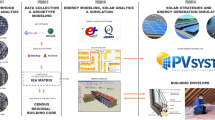Abstract
Purpose of Review
The concept of the smart city goes beyond the employment of advanced information and communication technologies (ICT) for better resource use as it also includes smarter and more efficient ways to heat and power buildings. The implementation of on-site renewable energy technologies, as well as the exploitation of the solar global irradiance for buildings passive heating, is a key element in the urban design of smart cities. This study aims to present an urban design concept for smart cities, which puts the spotlight on the optimal solar exposure of buildings, which will allow the maximization of smart building solar energy profit.
Recent Findings
The physics of the methodology of the proposed design concept, which is based on well-established principles of solar geometry, is presented. A case study concerning the incident radiation of alternative designs of equivalent built area within a 5000 m2 urban block is presented and discussed.
Summary
This study aspires to influence the discussion for the development of urban block design procedures in smart cities.




Similar content being viewed by others
References
European Commission. 2009. A technology roadmap for the communication on investing in the development of low carbon technologies. (SET-Plan). Available from: http://setis.ec.europa.eu/. Last accessed: December 9, 2016.
Kylili A, Fokaides PA. European smart cities: the role of zero energy buildings. Sustainable Cities and Society. 2015;15:86–95.
Kylili, A., & Fokaides, P. A. (2013). Investigation of building integrated photovoltaics potential in achieving the zero energy building target. Indoor and built environment.
Fokaides, P. A. (2011). Towards zero energy buildings (ZEB): the role of environmental technologies. Green and ecological technologies for urban planning: creating smart cities. Hershey, USA: IGI Global Publication, 93-111.
Fokaides PA, Maxoulis CN, Panayiotou GP, Neophytou MKA, Kalogirou SA. Comparison between measured and calculated energy performance for dwellings in a summer dominant environment. Energy and Buildings. 2011;43(11):3099–105.
Pyrgou A, Kylili A, Fokaides PA. The future of the Feed-in Tariff (FiT) scheme in Europe: the case of photovoltaics. Energy Policy. 2016;95:94–102.
Kylili A, Fokaides PA. Competitive auction mechanisms for the promotion renewable energy technologies: the case of the 50 MW photovoltaics projects in Cyprus. Renew Sust Energ Rev. 2015;42:226–33.
Fokaides PA, Kylili A, Pyrgou A, Koroneos CJ. Integration potentials of insular energy systems to smart energy regions. Energy Technology & Policy. 2014;1(1):70–83.
Fokaides PA, Christoforou EA, Kalogirou SA. Legislation driven scenarios based on recent construction advancements towards the achievement of nearly zero energy dwellings in the southern European country of Cyprus. Energy. 2014;66:588–97.
Kylili A, Fokaides PA, Jimenez PAL. Key performance indicators (KPIs) approach in buildings renovation for the sustainability of the built environment: a review. Renew Sust Energ Rev. 2016;56:906–15.
Fokaides PA, Kylili A. Towards grid parity in insular energy systems: the case of photovoltaics (PV) in Cyprus. Energy Policy. 2014;65:223–8.
Philokyprou M, Michael A, Malaktou E, Savvides A. Environmentally responsive design in eastern Mediterranean. The case of vernacular architecture in the coastal, lowland and mountainous regions of Cyprus. Build Environ. 2017;111:91–109.
Savvides A, Michael A, Malaktou E, Philokyprou M. Examination and assessment of insolation conditions of streetscapes of traditional settlements in the Eastern Mediterranean area. Habitat International. 2016;53:442–52.
Panayiotou GP, Kalogirou SA, Florides GA, Maxoulis CN, Papadopoulos AM, Neophytou M, et al. The characteristics and the energy behaviour of the residential building stock of Cyprus in view of Directive 2002/91/EC. Energy and Buildings. 2010;42(11):2083–9.
Fokaides PA, Papadopoulos AM. Cost-optimal insulation thickness in dry and mesothermal climates: existing models and their improvement. Energy and Buildings. 2014;68:203–12.
Vartholomaios A. A parametric sensitivity analysis of the influence of urban form on domestic energy consumption for heating and cooling in a Mediterranean city. Sustainable Cities and Society. 2017;28:135–45.
Petersen S, Momme AJ, Hviid CA. A simple tool to evaluate the effect of the urban canyon on daylight level and energy demand in the early stages of building design. Sol Energy. 2014;108:61–8.
Nel O, López J, Martín J, Checa J. Energy and urban form. The growth of European cities on the basis of night-time brightness. Land Use Policy. 2017;61:103–12.
Yang PPJ. Energy resilient urban form: a design perspective. Energy Procedia. 2015;75:2922–7.
Sokol J, Davila CC, Reinhart CF. Validation of a Bayesian-based method for defining residential archetypes in urban building energy models. Energy and Buildings. 2017;134:11–24.
Davila CC, Reinhart CF, Bemis JL. Modeling Boston: a workflow for the efficient generation and maintenance of urban building energy models from existing geospatial datasets. Energy. 2016;117:237–50.
Yang PPJ, Yan J. Modeling urban design with energy performance. Energy Procedia. 2016;88:3–8.
Samuelson H, Claussnitzer S, Goyal A, Chen Y, Romo-Castillo A. Parametric energy simulation in early design: high-rise residential buildings in urban contexts. Build Environ. 2016;101:19–31.
de Lemos Martins TA, Adolphe L, Bastos LEG, de Lemos Martins MA. Sensitivity analysis of urban morphology factors regarding solar energy potential of buildings in a Brazilian tropical context. Sol Energy. 2016;137:11–24.
Liu BY, Jordan RC. The interrelationship and characteristic distribution of direct, diffuse and total solar radiation. Sol Energy. 1960;4(3):1–19.
Author information
Authors and Affiliations
Corresponding author
Ethics declarations
Conflict of Interest
The authors declare that they have no conflict of interest.
Human and Animal Rights and Informed Consent
This article does not contain any studies with human or animal subjects performed by any of the authors.
Additional information
This article is part of the Topical Collection on Building Sustainability
Rights and permissions
About this article
Cite this article
Pyrilli, D., Savvides, A.L. & Fokaides, P.A. The Impact of Urban Design on the Realization of the Zero Energy Building Target Through On-site Energy Production: a Case Study. Curr Sustainable Renewable Energy Rep 4, 72–86 (2017). https://doi.org/10.1007/s40518-017-0072-6
Published:
Issue Date:
DOI: https://doi.org/10.1007/s40518-017-0072-6








